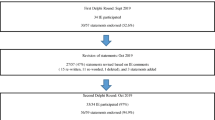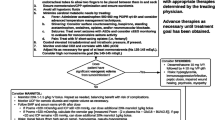Abstract
Introduction
Craniofacial procedures may be needed to address symptomatic intracranial hypertension. The authors review their institutional experience in the treatment of children with symptomatic increased intracranial pressure (ICP) utilizing craniofacial reconstructive procedures.
Methods
The senior authors’ (HSM, SRC) craniofacial experience of 222 patients over a 7-year period from 2000 to 2007 at a single institution (Rady Children’s Hospital, San Diego) is reviewed. Seventeen patients were identified who were felt to be candidates for craniofacial surgery with symptomatic increased ICP.
Results
Patient diagnoses included single-suture craniosynostosis, craniofacial dysostoses, shunt-induced craniostenosis, and shunt-associated intracranial hypertension (slit-ventricle syndrome). Seventeen patients underwent 21 craniofacial procedures. Age at surgery ranged from 3 months to 13 years with a mean of 5 years. Preoperative symptoms and signs included headaches, unexplained irritability, seizures, papilledema, and visual loss. All patients had diagnostic neuroimaging. Seven patients had preoperative invasive ICP measurements. Surgery was deferred on three of these patients based on these measurements. The mean total operative (including anesthetic preparation) and surgical times were 3 h 12 min and 2 h 20 min, respectively. Percentage operative blood loss averaged 11.3%. In six procedures, no transfusions were required. Average hospital stay was 4 days. There was no perioperative mortality or significant surgery associated morbidity. All patients have had postoperative clinical improvement in signs and symptoms of increased ICP.
Conclusions
Using modern diagnostic and surgical techniques, including invasive ICP monitoring, increased intracranial pressure can be successfully managed by an experienced, multidisciplinary, craniofacial team. Our treatment paradigm and operative management scheme is discussed.



Similar content being viewed by others
References
Agrawal D, Steinbok P, Cochrane DD (2007) Significance of beaten copper appearance on skull radiographs in children with isolated sagittal synostosis. Childs Nerv Syst 23(12):1467–1470
Blount JP, Louis RG, Tubbs RS, Grant JH (2007) Pansynostosis: a review. Childs Nerv Syst 23(10):1103–1109
Bristol RE, Lekovic GP, Rekate HL (2004) The effects of craniosynostosis on the brain with respect to intracranial pressure. Semin Pediatr Neurol 11(4):262–267
Cohen SR, Dauser RC, Newman MH, Muraszko K (1993) Technical strategies: Surgical techniques of cranial vault expansion for increases in intracranial pressure in older children. J Craniofac Surg 4(3):167–176
Cohen SR, Pryor L, Mittermiller PA, Meltzer HS, Levy ML, Broder KW, Ozgur BM (2008) Nonsyndromic craniosynostosis: current treatment options. Plast Surg Nurs 28(2):79–91
Cohen SR, Persing JA (1998) Intracranial pressure in single-suture craniosynostosis. Cleft Palate Craniofac J 35(3):194–196
Connolly JP, Gruss J, Seto ML, Whelan MF, Ellenbogen R, Weiss A, Buchman SR, Cunningham ML (2004) Progressive postnatal craniosynostosis and increased intracranial pressure. Plast Reconstr Surg 113(5):1313–1323
David LR, Velotta E, Weaver RG, Wilson JA, Argenta LC (2002) Clinical findings precede objective diagnostic testing in the identification of increased ICP in syndromic craniosynostosis. J Craniofac Surg 13(5):676–680
Eide PK, Helseth E, Due-Tonnessen B, Lundar T (2002) Assessment of continuous intracranial pressure recordings in childhood craniosynostosis. Pediatr Neurosurg 37(6):310–320
Gault DT, Renier D, Marchac D, Jones BM (1992) Intracranial pressure and intracranial volume in children with craniosynostosis. Plast Reconstr Surg 90(3):377–381
Hudgins RJ, Cohen SR, Burstein FD, Boydston WR (1998) Multiple sutre synostosis and increased intracranial pressure following repair of single suture, nonsyndromal craniosynostosis. Cleft Palate Craniofac J 35(2):167–172
Inagaki T, Kyutoku S, Seno T, Kawaguchi T, Yamahara T, Oshige H, Yamanouchi Y, Kawamoto K (2007) The intracranial pressure of the patients with mild form of craniosynostosis. Childs nerv Syst 23(12):1455–1459
Jensen RL, Hahn YS, Ciro E (1997) Risk factors of intracranial pressure monitoring in children with fiberoptic devices: a critical review. Surg Neurol 47(1):16–22
Kapp-Simon K (1998) Mental development and learning disorders in children with single suture craniosynostosis. Cleft Palate Craniofac J 35(3):197–203
Kapp-Simon KA, Speltz ML, Cunningham ML, Patel PK, Tomita T (2007) Neurodevelopment of children with single suture craniosynostosis: a review. Childs Nerv Syst 23(3):269–281
Martinez-Lage JF, Alamo L, Poza M (1999) Raised intracranial pressure in minimal forms of craniosynostosis. Child's Nerv Syst 15(1):11–15
Mouradian WE (1998) Controversies in the diagnosis and management of craniosynostosis: a panel discussion. Cleft Palate Craniofac J 35(3):190–3
Ozgur BM, Aryan HE, Ibrahim D, Soliman MA, Meltzer HS, Cohen SR, Levy ML (2006) Emotional and psychological impact of delayed craniosynostosis repair. Childs Nerv Syst 22(12):1619–1623
Renier D, Sainte-Rose C, Marchac D, Hirsch JF (1982) Intracranial pressure in craniostenosis. J Neurosurg 57(3):370–377
Rich PM, Cox TCS, Hayward RD (2003) The jugular foramen in complex and syndromic craniosynostosis and its relationship to raised intracranial pressure. Am J Neuroradiol 24(1):45–51
Scott JR, Isom CN, Gruss JS, Salemy S, Ellenbogen RG, Avellino A, Birgfeld C, Hopper RA (2009) Symptom outcomes following cranial vault expansion for craniosynostosis in children older than 2 years. Plast Reconstr Surg 123(1):289–297
Siddiqi SN, Posnick JF, Buncic R, Humphreys RP, Hoffman HJ, Drake JM, Rutka JT (1995) The detection and management of intracranial hypertension after initial suture release and decompression for craniofacial dysostosis syndrome. Neurosurg 36(4):703–709
Stavrou P, Sgouros S, Willshaw HE, Goldin JH, Hockley AD, Wake MJC (1997) Visual failure caused by raised intracranial pressure in craniosynostosis. Childs Nerv Syst 13(2):64–67
Tamburrini G, Caldarelli M, Massimi L, Santini P, Di Rocco C (2005) Intracranial pressure monitoring in children with single suture and complex craniosynostosis: a review. Childs nerv Syst 21(10):913–921
Tamburrini G, Di Rocco C, Velardi F, Santini P (2004) Prolonged intracranial pressure (ICP) monitoring in non-traumatic pediatric neurosurgical diseases. Med Sci Monit 10(4):MT53–63
Taylor WJ, Hayward RD, Lasjaunias P, Britto JA, Thompson DN, Jones BM, Evans RD (2001) Enigma of raised intracranial pressure in patients with complex craniosynostosis: the role of abnormal intracranial venous drainage. J Neurosurg 94(3):377–385
Teo C, Morris W (1999) Slit ventricle syndrome. Contemporary Neurosurgery 21(3):1–4
Thompson DNP, Harkness W, Jones B, Gonsalez S, Andar U, Hayward R (1995) Subdural intracranial pressure monitoring in craniosynostosis: its role in surgical management. Child's Nerv Syst 11(5):269–275
Thompson DN, Jones BM, Harkness W, Gonsalez S, Hayward RD (1997) Consequences of cranial vault expansion surgery for craniosynostosis. Pediatr Neurosurg 26(6):296–303
Tuite GF, Chong WK, Evanson J, Narita A, Taylor D, Harkness WF, Jones BM, Hayward RD (1996) The effectiveness of papilledema as an indicator of raised intracranial pressure in children with craniosynostosis. Neurosurg 38(2):272–278
Tuite GF, Evanson J, Choong WK, Thompson D, Harkness WF, Jones BM, Hayward RD (1996) The beaten copper cranium: a correlation between intracranial pressure, cranial radiographs, and computed tomographic scans in children with craniosynostosis. Neurosurg 39(4):691–699
Weinzweig J, Bartlett SP, Chen JC, Losee J, Sutton L, Duhaime AC, Whitaker LA (2008) Cranial Vault expansion in the management of postshunt craniosynostosis and slit ventricle syndrome. Plast Reconstr Surg 122(4):1171–1180
Conflict of interest
The authors declare that they have no conflict of interest.
Author information
Authors and Affiliations
Corresponding author
Rights and permissions
About this article
Cite this article
Baird, L.C., Gonda, D., Cohen, S.R. et al. Craniofacial reconstruction as a treatment for elevated intracranial pressure. Childs Nerv Syst 28, 411–418 (2012). https://doi.org/10.1007/s00381-011-1615-6
Received:
Accepted:
Published:
Issue Date:
DOI: https://doi.org/10.1007/s00381-011-1615-6




